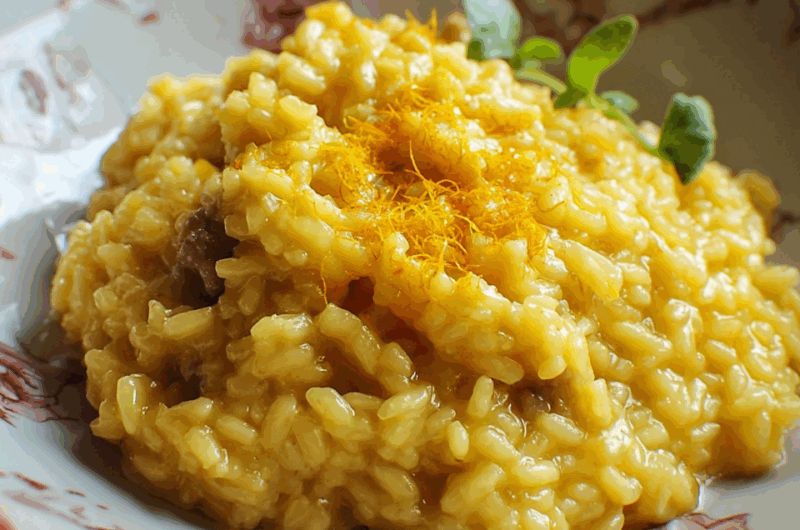The iconic Risotto alla Milanese is a dish that exudes both warmth and sophistication. Originating from the heart of Northern Italy, this creamy, golden-hued rice is elevated by the luxurious infusion of saffron—a spice once reserved for royalty. The richness of butter and depth of beef broth marry beautifully with nutty Parmesan, making every bite pure indulgence.
Whether served as a first course or paired with osso buco for a classic Milanese meal, this risotto brings comfort and elegance to the table. Its vibrant yellow color and velvety texture will impress guests and satisfy cravings. And the best part? It’s far simpler to make than it looks. Let this recipe transport your kitchen to the cobbled streets of Milan.
Full Recipe:
-
1/4 cup unsalted butter, divided
-
1 small onion, finely chopped
-
1 tablespoon beef bone marrow (optional but traditional)
-
1 1/2 cups Arborio rice
-
1/2 cup dry white wine
-
4 cups hot beef stock (preferably homemade or low-sodium)
-
1/2 teaspoon saffron threads, soaked in 2 tablespoons warm water
-
3/4 cup freshly grated Parmesan cheese
-
Additional Parmesan for serving
-
Salt, to taste
Directions:
-
In a medium saucepan over low heat, melt half the butter. Add chopped onion and bone marrow. Let them simmer gently for about 10 minutes, stirring occasionally, until the onion softens.
-
Remove the onion and marrow with a slotted spoon (optional—you may leave them in if preferred).
-
Add Arborio rice to the pan and increase the heat to medium. Toast the rice for 5–7 minutes, stirring constantly until lightly golden.
-
Pour in the white wine and stir until absorbed.
-
Begin adding the hot beef stock, one ladle at a time, stirring frequently and letting each addition absorb before adding the next. Continue until rice is almost al dente, about 18–20 minutes.
-
Stir in saffron (with soaking liquid), remaining butter, and 3/4 cup of Parmesan. Turn off the heat, cover the pan, and let the risotto rest for 5 minutes.
-
Serve hot, either as a side to osso buco or as a stand-alone dish with extra Parmesan sprinkled on top.
Prep Time: 10 minutes | Cooking Time: 30 minutes | Total Time: 40 minutes
Kcal: 410 kcal | Servings: 4 servings
Origins of Risotto alla Milanese
Risotto alla Milanese is a celebrated Italian dish known for its rich saffron-infused flavor and vibrant golden hue. It hails from Milan, the capital of Lombardy in Northern Italy, a region renowned for its sophisticated cuisine and emphasis on quality ingredients. The recipe dates back to the 16th century and has since become a cornerstone of traditional Milanese dining.
Unlike southern Italian dishes that are tomato-based or heavily seasoned, the cuisine of Northern Italy often highlights dairy products, butter, and rice, thanks to the region’s cooler climate and fertile plains. Risotto alla Milanese epitomizes this culinary approach, with its use of butter, Parmesan cheese, beef marrow, and saffron, coming together in a dish that is both indulgent and elegant.
The Role of Saffron: The Star Ingredient
The defining characteristic of Risotto alla Milanese is its golden color and aromatic profile, both of which come from saffron. This precious spice, harvested from the stigmas of the Crocus sativus flower, lends a deep, earthy aroma and subtle bitterness that balance the richness of the dish.
Saffron is one of the most expensive spices in the world by weight, which historically made this dish a symbol of wealth and celebration in Milanese culture. Its inclusion in the recipe is not merely decorative—it transforms the flavor and appearance of the risotto, making it instantly recognizable and deeply memorable.
Soaking saffron in warm liquid before adding it to the rice helps release its full spectrum of flavor and color. A small amount goes a long way, and the vibrant yellow color it imparts is naturally beautiful, requiring no artificial additives.
Cultural Significance in Milanese Cuisine
In Milan, food is closely tied to tradition and identity, and Risotto alla Milanese holds a special place on the city’s culinary pedestal. It’s not just a dish—it’s a cultural icon, often prepared for family gatherings, holidays, and special occasions.
It is especially famous as a traditional accompaniment to osso buco, a slow-braised veal shank dish. The creamy risotto serves as a luxurious bed for the tender meat, absorbing the flavorful juices and complementing the dish with its buttery, cheesy profile. This pairing is so classic that many Milanese restaurants serve them together as a single entrée.
The dish also has historic ties to religious and artistic rituals. One famous (though partly mythical) origin story dates back to 1574 when a young glassmaker in Milan, nicknamed “Zafferano” (Italian for saffron), accidentally stained rice with the pigment while working on the windows of Milan’s Duomo Cathedral. The vibrant yellow rice was so well-received at a wedding feast that it became a cherished regional specialty.
Why Arborio Rice Matters
To make a great risotto, the choice of rice is critical. Risotto alla Milanese traditionally uses Arborio rice, a short-grain variety grown in the Po Valley of Northern Italy. This rice is uniquely suited for risotto because it has a high starch content and absorbs liquid gradually.
As it cooks, Arborio rice releases its starch into the broth, creating that signature creamy texture without the need for cream. The grains remain tender yet slightly al dente at the core, giving the risotto its distinct “bite.”
While Arborio is the most commonly available variety, other types such as Carnaroli or Vialone Nano are also excellent choices for risotto, often preferred by chefs for their superior texture and resistance to overcooking.
Traditional Techniques and Cooking Tips
Risotto alla Milanese is a dish that rewards patience and attention to detail. It is traditionally prepared by slowly adding warm broth to the rice, one ladle at a time, while stirring constantly. This method not only ensures even cooking but also coaxes the rice to release its starch, forming that iconic velvety sauce.
The cooking process usually takes about 18 to 20 minutes, but what makes the dish shine is the final mantecatura—the technique of stirring in cold butter and grated Parmesan cheese at the end. This final step enriches the risotto, giving it a glossy finish and luxurious mouthfeel.
Another important traditional component is the use of beef marrow, which adds a rich, umami-laden undertone to the base of the risotto. While not always used in modern versions, it is a hallmark of authenticity in Milanese kitchens.
Modern Variations and Dietary Adaptations
As with many traditional recipes, Risotto alla Milanese has been adapted over the years to suit contemporary tastes and dietary preferences. Some cooks replace beef broth with vegetable stock for a vegetarian version, while others omit the bone marrow entirely or use ghee instead of butter for a lactose-free adaptation.
Though purists may argue against altering the original, these modifications allow the dish to be enjoyed by a wider audience while preserving its essence. Some modern recipes also include a touch of cream for added richness, though traditionalists would say it’s unnecessary if the rice is cooked correctly.
Additionally, chefs around the world have taken creative liberties with the presentation—pairing the risotto with grilled scallops, pan-seared mushrooms, or even shaved truffle to elevate the dish into a fine-dining experience.
Pairing Suggestions: What to Serve With It
Risotto alla Milanese can shine on its own or serve as a complementary side. When served solo, it’s often enjoyed as a primo (first course) in a multi-course Italian meal. However, its true glory comes when paired with classic Milanese proteins like osso buco alla Milanese, roasted lamb, or braised short ribs.
When it comes to wine, the richness of this risotto calls for something with acidity and structure to cut through the creaminess. A dry white wine such as Gavi, Pinot Grigio, or Verdicchio makes an excellent match. For red wine lovers, a light-bodied Nebbiolo or Chianti can complement the dish without overwhelming its delicate flavors.
As a side dish, the risotto’s mild saffron flavor pairs beautifully with earthy elements like roasted vegetables, caramelized onions, or sautéed mushrooms.
Why This Dish Stands the Test of Time
There’s a reason Risotto alla Milanese has been passed down through generations and celebrated across continents. Its unique blend of comfort, elegance, and cultural history makes it more than just a rice dish—it’s an experience. Every spoonful tells a story of Italian heritage, culinary precision, and timeless flavor.
Unlike many trendy recipes that fade in and out of popularity, Risotto alla Milanese continues to captivate chefs and home cooks alike. It’s both rustic and refined—a true emblem of Italian culinary mastery. Its adaptability to different palates and settings also makes it suitable for weeknight dinners or sophisticated dinner parties alike.
Whether you’re cooking it for the first time or the hundredth, the slow, meditative process of preparing risotto is as rewarding as the result itself.
Conclusion: The Heart of Milan on a Plate
Risotto alla Milanese is far more than a bowl of creamy rice—it’s a love letter to the traditions, ingredients, and people of Northern Italy. From the romantic history of its saffron origins to the disciplined technique required to perfect it, this dish offers a deeply satisfying culinary experience that bridges past and present.
If you’re looking to bring a piece of authentic Italian culture into your home kitchen, this dish is the perfect place to start. Its golden hue and rich aroma make it visually stunning, while the balanced flavors and luxurious texture make it unforgettable. Whether served alone or as part of a grand Milanese feast, Risotto alla Milanese always delivers comfort, warmth, and sophistication in every bite.








